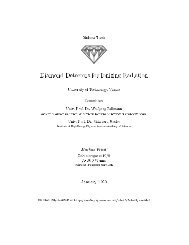You also want an ePaper? Increase the reach of your titles
YUMPU automatically turns print PDFs into web optimized ePapers that Google loves.
4 Level-1 TriggerThe Level-1 Trigger is the first stage of the event selection process. It has to rendera decision to retain or discard an event on every bunch crossing. While this decisionis made, all data gathered has to be retained in the detector. The amount of memoryavailable in the tracker and preshower detectors limits this retention period to with 128bunch crossings (3.2µs). Given the detector technologies used (with DT drift timesof up to 400 ns) and the size of the detector and counting room (signal propagationtimes add up to 1 µs), the time for actual decision logic calculations is reduced evenfurther. To produce a decision on each bunch crossing, the trigger system needs torun as a pipeline, with multiple bunch crossings in various stages of processing atthe same time. Because it is not possible to process information from the preshowerand tracker detectors quickly enough, the trigger only considers physics objects fromthe calorimeter and muon subsystems. Figure 4.1 shows a high-level view of thesubsystems of the Level-1 Trigger. Both the calorimeter and the muon trigger havea similar processing flow, starting with the generation of so-called trigger primitives,which are determined locally on detector elements. These primitives are then combinedinto object candidates by regional triggers, and a global subsystem trigger stage selectsthe most interesting of these candidates. The final stage is the Global Trigger (GT),combining information from the subsystems and implementing the event selectioncriteria derived from physics requirements.4.1 Calorimeter TriggerThe calorimeter trigger identifies the most energetic electrons, photons and jets in anevent. In addition, it calculates a number of global properties, such as the missingtransverse energy (due to undetected particles). It encompasses information fromthe ECAL, HCAL and HF subdetectors. For trigger purposes, the calorimeters aredivided into 52 × 72 (η × φ) so-called trigger towers (see Fig. 4.2), imposing a commongeometry on both the ECAL and HCAL subdetectors. The HF calorimeter does notshare geometric coverage with the other subdetectors and contains an additional 4×18trigger towers in each endcap.4.1.1 ECAL Trigger Primitive GenerationIn the electromagnetic calorimeter, each trigger tower consists of 5 × 5 crystals. Theanalog signals from the scintillators are digitized on four parallel amplifiers with gainsof 33, 9, 5 and 1 respectively, forwarding the signal from the lowest non-overflowingamplifier as the result. This is encoded in a pseudo-floating point format (12 bits of36












